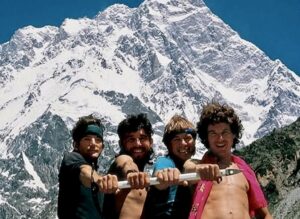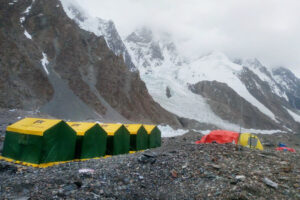Reinhold Messner named it the “Magic Line”, a dangerous route along K2’s south-southwest ridge that climbers regarded as the most difficult challenge of the era. We take a look at the legacy of the line and the climbers who attempted this impressive new route.
Attempts begin in 1979
The first attempts at this incredibly difficult undertaking occurred in the summer of 1979.
An Italian-German-Austrian team featured Reinhold Messner, Friedl Mutschlechner, Renato Casarotto, Alessandro Gogna, Michael Dacher, and Robert Schauer. Unfortunately, the group was delayed by three weeks and arrived very late at Base Camp. Since they planned to climb alpine style, it soon became apparent that the line was too complex for the limited time they had.

The southwestern slopes of K2. Photo: Sebastian Alvaro
Messner decided that his group should abandon the idea and instead climb the normal route via the Abruzzi Spur. They did so and reached the summit on July 12, 1979. At the time, it was only the fourth ascent of K2.

Reinhold Messner scouts a route. Photo: Reinhold Messner
Messner’s choice wasn’t popular with the entire team. Casarotto, extremely eager to climb the Magic Line, took Messner’s decision badly. He believed that Messner had been scared and could not forgive him for not even attempting the route.
The first true attempt
That same summer, a large French team of 15 members, under the leadership of Bernard Mellet, arrived at K2 Base Camp on July 9, 1979. A large number of porters accompanied them.
On July 10, they established Camp 1 at 5,600m. It took until July 20 to fix the route to Camp 3 at 6,950m. Then bad weather set in for a week. After a long wait, they were able to establish Camp 4 at 7,500m on August 1.
A short weather window allowed Mellet and Yannick Seigneur to reach 7,800m, but shortly after, bad weather struck once again. On September 1, they set up Camp 5 at 8,000m. However, the weather remained unstable.
On September 9, Daniel Monaci, Thierry Leroy, and Ivano Ghirardini pushed for the summit, but two of them had to turn back at around 8,350m because of the early arrival of winter cold. Ivano Ghirardini remained at 8,350m and bivouacked alone without oxygen in a snow cave, still hoping to try for the summit. But the next day, a storm forced him to descend as well. This ended the team’s attempt.

Expedition leader Bernard Mellet. Photo: Jean-Luc Rigaux
A busy year: 1986
In 1986, the Magic Line was still unopened. However, in 1981, Eiho Otani of Japan and Nazir Ahmad Sabir of Pakistan climbed the upper section of the Magic Line pillar, from 8,400m to the summit, while opening their route on the West Face of K2.
In 1986, there were a remarkable number of major K2 projects on the go. Sadly, this also translated into 13 deaths. Twenty-seven people summited K2 and three new routes were opened, all with a high level of commitment.
Nine expeditions based themselves on the south side of K2. Four of these intended to climb the Magic Line: an American group, an Italian team, a solo Italian climber, and a Polish-Slovakian group. The Americans and Italians set Camp 3 at 6,800m and then, except for two Americans, retreated to Base Camp.
After setting up Camp 3, the Italian team switched their focus to Broad Peak, with plans to return to K2 later.

The serac above the Bottleneck on K2, at about 8,300m. Photo: Rolf Zemp
On June 21, shortly after Americans John Smolich and Alan Pennington left Camp 1 for Camp 2, a boulder fell from the ridge above them, causing an avalanche that killed both climbers. Understandably, the remaining Americans aborted their expedition.
Hearing of the deaths, the Italian team under the leadership of Agostino Da Polenza changed their route and instead climbed the Abruzzi Spur.
Casarotto returns
Renato Casarotto returned to K2 to try the Magic Line, hoping to prove that Messner’s decision in 1979 had been a poor one. Casarotto teamed up with two Spanish climbers, Mari Abrego and Josema Casimiro, who were climbing on the Abruzzi route. Casarotto intended to veer off to the right on the last, upper section of the route. He made three solo attempts that summer. The first was on June 23, when he reached 8,200m. On July 5, he tried again but didn’t make it any higher.
About 10 days later, he tried for a third time, reaching 8,300m before turning around because of a bad weather forecast. His descent seemed to be going well, when on July 16, an hour from Base Camp, he fell into a 40m deep crevasse.
Casarotto managed to get the radio out of his backpack and called his wife at Base Camp for help. Climbers and doctors quickly mobilized and were able to find him alive. They pulled him out of the crack, but Casarotto died soon after.

Renato Casarotto. Photo: Summitpost
The first ascent
But that summer, three members of a strong Polish-Slovakian team, led by Janusz Majer, finally completed the Magic Line. On August 3, 1986, Wojciech Wroz, Przemyslaw Piasecki, and Petr Bozic reached the summit.
There, they decided to descend by the Abruzzi route. Five-and-a-half hours later, at 8,100m, while rappelling down the Bottleneck in the dark, Wroz fell to his death. It is not known exactly what happened because Wroz was bringing up the rear of the group and only the first in line had a headlamp.
Majer’s team dedicated the climb to the memory of Pennington, Smolich, Casarotto, and Wroz.

Polish mountaineers Janusz Majer and Walenty Fiut stand on top of Broad Peak with K2 in the background. July 1984. Photo: Ryszard Pawlowski
The American team, writing for the American Alpine Club, wrote that “most certainly our work on the lower half of the route was instrumental in their success, and so we share their feeling of victory on what Renato Casarotto had referred to as the most difficult route in all the Himalaya and Karakoram.”
For his part, Majer also mentioned that they were able to use ropes set by the Americans and the Italians.
The collective efforts of a procession of teams had finally helped solve the most difficult route of the era.
Lone repeat
Since the first ascent, there has only been one repeat of the Magic Line. In 2004, Catalan climber Jordi Corominas summited at midnight, solo. Two members of his team turned back and Corominas climbed alone in the dark from 8,300m, without O2.






